April itinerary in Japan Day 3 (Ehime Prefecture)
(Wednesday, April 20)
Table of contents
1. Uwajima Historical Museum / Kabasaki Battery Site
3. Tensha-en Garden, Nanyo Gokoku Shrine, Kiya Ryokan
1. Uwajima Historical Museum / Kabasaki Battery Site
In the morning of April 20th (Wednesday), I rented a bicycle at the Uwajima City Tourist Information Center “Shiroshita” and went around the city of Uwajima. I think that the rental cycle is the best because the distance for sightseeing in Uwajima city is too long to go around on foot and the number of buses is small for going around by bus. Uwajima City Tourist Information Center “Shiroshita” is a new facility that just opened in August 2021 at the entrance of Uwajima Castle. The rental cycle fee is Yen 2,000 a day for GIANT’s E-bike.
The Uwajima Historical Museum has been relocated and used as a building built as the Uwajima Police Station in 1884. The light pink building creates a soft atmosphere that does not seem to be a former police station. The architectural style is pseudo-Western style architecture. It is a national registered tangible cultural property. It takes a little over 15 minutes to walk from the Uwajima City Tourist Information Center “Shiroshita” to the Uwajima Historical Museum, but it took less than 5 minutes by bicycle.
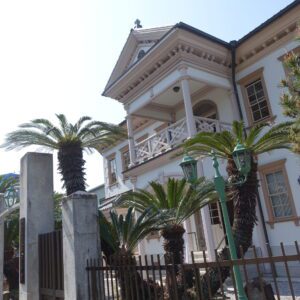
Next to the Uwajima Historical Museum is the Kabasaki Battery Site. The Kabasaki Battery Site is the site of a battery built in 1855. It is one of the batteries built in the Uwajima domain for coastal defense against foreign ships. It is a turret trace that remains very beautiful.
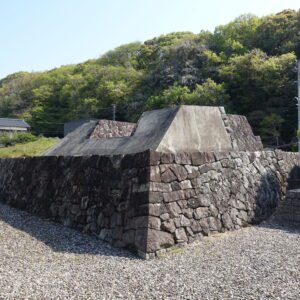
2. Warei Shrine / Taga Shrine
I went to the Warei Shrine near the site of Kabasaki Battery, Uwajima Historical Museum. It takes a little over 15 minutes on foot, but it took less than 5 minutes by bicycle.
Warei Shrine is a shrine whose main deity is Kinyori Yanbe. Kinyori Yanbe is a chief vassal of the Date clan who served Masamune Date of the Sendai clan and was assigned as a first chief vassal when Masamune’s son Hidemune Date was moved by the Uwajima clan. Kinyori Yanbe was loved by people of the domain because he tried to lighten the land tax.
However, he was killed in 1620 after being resented by political opponents due to a battle for initiative within the Uwajima domain. After that, the vassals who defeated Koyori Yamake died, and the Uwajima domain was feared as a evil consequence of Kinyori Yanbe because of a series of large earthquakes, typhoons, and starvation. The Warei Shrine was to be built in 1653 to calm the worship of Kinyori Yanbe.
The “Uwajima Ushioni Matsuri (festival)”, which is held every July, is one of the famous festivals in Shikoku. It is the protagonist of the festival, “Ushioni”. Ushioni has a long neck made of log, a demon-faced head, and a sword-shaped tail on a bamboo-framed body that resembles a cow of over 5m. The mask of Ushioni is also displayed in the main shrine of Warei Shrine.

I felt that the main shrine of Warei Shrine was very nice and beautiful. The current main shrine was built in 1951.

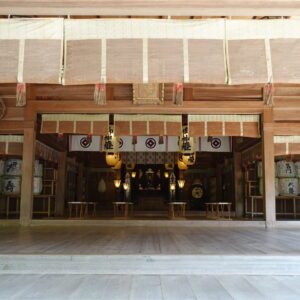
The second torii gate of Warei Shrine is the largest stone structure in Japan (height over 12m). The Taiko Bridge (Kamiyuki Bridge) spans the Sukagawa River that runs between the second torii gate and the shrine gate of Warei Shrine. The Taiko Bridge, which only humans can pass through, has a very nice atmosphere.

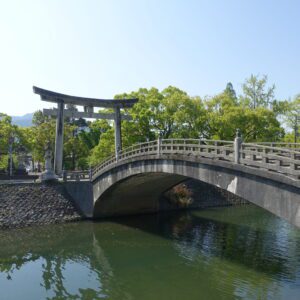
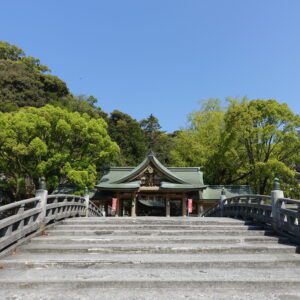
A votive tablet by Hidekichi Shigemoto, a sumi-e artist from Matsuyama City, Ehime Prefecture, is installed in the precincts of Warei Shrine.
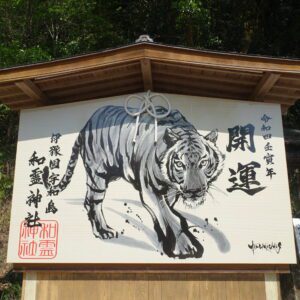
Next to Warei Shrine, I went to Taga Shrine, which is less than 10 minutes on foot. I arrived by bicycle in a few minutes. Taga Shrine is also known as a Dekoboko shindou and is famous for its collection of sexual customs. I didn’t enter the Sexual Culture Property Museum in the precincts of Taga Shrine because the entrance fee was expensive (Yen 800).
This Sexual Culture Property Museum is said to be “the best sexual museum in the world”, and tens of thousands of valuable materials related to sexuality from all over the world are exhibited. Minors and frivolous people are prohibited from entering. The torii gate at Taga Shrine had a very unusual shape.
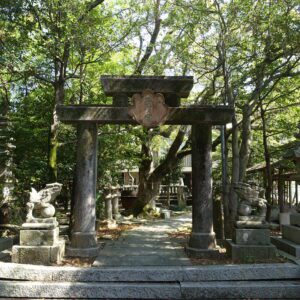


3. Tensha-en Garden, Nanyo Gokoku Shrine, Kiya Ryokan
After Taga Shrine, I went to Tensha-en Garden. It takes a little over 20 minutes on foot, but it takes about 5 minutes by bicycle.
Tensha-en Garden is Chisen-Kaiyu-shiki-teien (go around the pond style garden) built by the 7th feudal lord Munetada Date as a place of retreat. The garden was completed in 1866 and was named “Tensha-en Garden”. It is a national scenic spot. Munetada Date lived until the age of 98, which is quite a longevity for the Edo period. I think he enjoyed the retreat place “Tensha-en Garden” for many years.
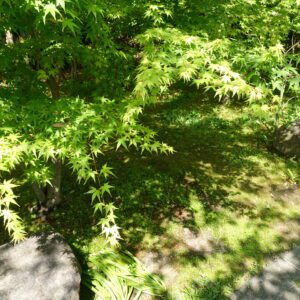
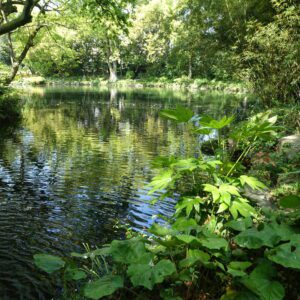

There are many wisteria trellis in the park. It was just the time when the wisteria bloomed (mid-April to early May), and I enjoyed walking around. The Siberian irises were also in full bloom. The Iris roots are in full bloom in early June.

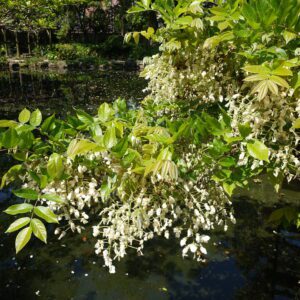
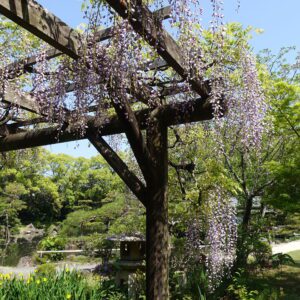
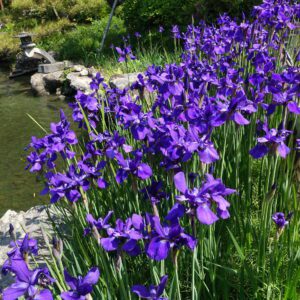
Admission: Adults Yen 500 yen, high school / elderly (65 years old and over) Yen 300 , junior high school students Yen 200, elementary school students Yen 100
Nanyo Gokoku Shrine is about a 10-minute walk from Tensha-en Garden. It took about 2 minutes by bicycle. Nanyo Gokoku Shrine was founded in 1914 with the first feudal lord of the Uwajima domain, Date Hidemune, the fifth feudal lord, Muratoki, the seventh feudal lord, Munetada, and the eighth feudal lord, Munenari. It is next to the “Nobori-tachi gate” of Uwajima Castle.

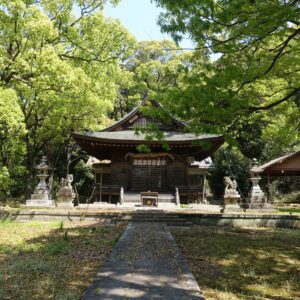
Kiya Ryokan is about a 10-minute walk from Nanyo Gokoku Shrine. It took about 2 minutes by bicycle. Kiya Ryokan was a two-story wooden inn that opened as a merchant inn in 1911. In 2012, it was reopened as a new Kiya Ryokan with only one group per day. It is a national registered tangible cultural property.
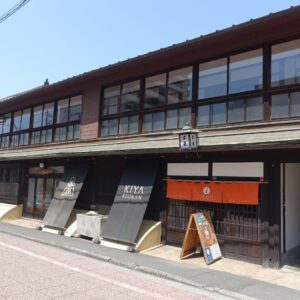
The time I had for sightseeing in Uwajima was just 2 hours. Since it was a bicycle, I was able to go around the tourist spots quite efficiently.
4. Uno-machi cityscape
After lunch, I went to “Traditional Buildings Preservation District, Uno-machi, Uwa-cho, Seiyo City”. The transportation I used is as follows.
Depart Uwajima Station at 11:50, Yosan Line Limited Express Uwakai No. 14 “bound for Matsuyama”, arrive at Unomachi Station at 12:09, Fare Yen 1,530
“Traditional Buildings Preservation District, Uno-machi, Uwa-cho, Seiyo City” has been selected as an national Important Preservation Districts for Groups of Traditional Buildings. Unomachi is a town that prospered as a post town for the Uwajima domain. The old architecture of the Meiji era (1868-1912) and the Taisho era (1912-1926) remains, and it was a fun city to take a leisurely walk.
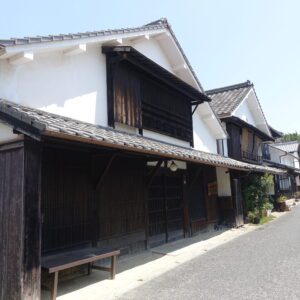
Kaimei School is an elementary school building with a pseudo-Western style architecture built in 1882 with the donation of the townspeople. It was the oldest elementary school in Shikoku. The building is donated by the townspeople, which conveys the enthusiasm for education in Unomachi during the Meiji era. It is a national important cultural property. Kaimei School has a sister building tie-up with the former Kaichi School (Matsumoto City, Nagano Prefecture), which is a national treasure.
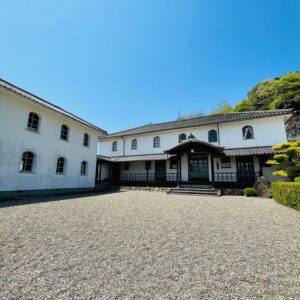
Kaimei School exhibits about 6,000 items such as pre-WWII textbooks and school management materials. The classroom of the Meiji era has been reproduced, and it feels like we have slipped back in time. Kaimei School is also visited by the famous writer Ryotaro Shiba, and is featured in “Kaido wo iku, Minami Iyo / Nishi Tosa Road”.
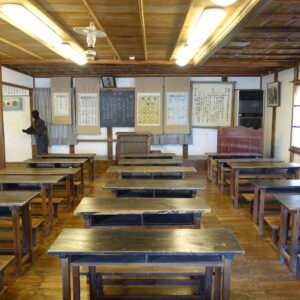
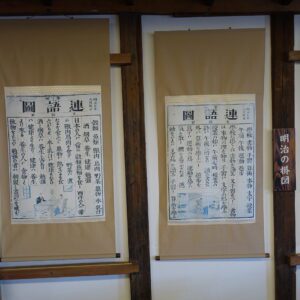
The Uwa Mingukan has a collection of about 6,000 folk tools that were actually used in Uno-machi from the end of the Edo period to the beginning of the Showa period. It was a very enjoyable folk museum to see the large number of exhibits and the skill of the exhibition. I think Uwa Mingukan is one of the leading folk museums in Japan. By all means, it is a folk museum that I would like everyone to visit. It has become a folk museum that I would like to visit every year.
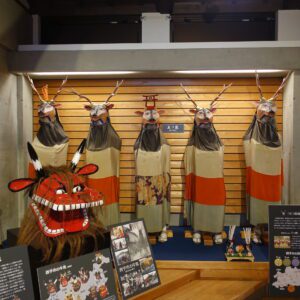
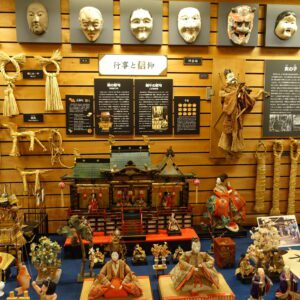

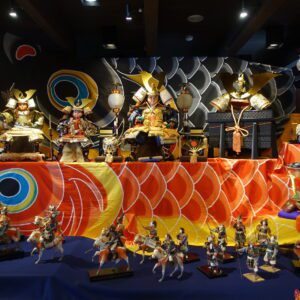
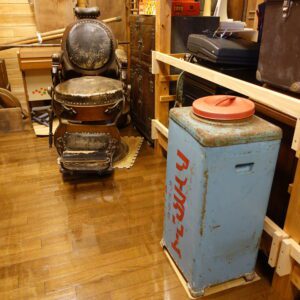
Admission fee (common to Kaimei School and Uwa Mingukan): Yen 500 for high school students and above, Yen 300 for elementary and junior high school students
The Suemitsu family residence is a townhouse built in 1770. The Suemitsu family established “Unomachi Soy Sauce Co., Ltd.” in 1919, and was engaged in the manufacture and sale of soy sauce until 1937. It is a cultural property designated by Seiyo City.

Matsuya Ryokan is a long-established inn with a long history where many writers and politicians such as Inazo Nitobe and Hisoka Maejima stayed. It is currently closed and is open as Daiichi Business Hotel Matsuya.
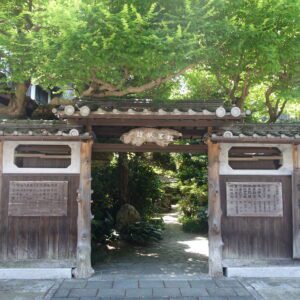
The Uwa Rice Museum has relocated the former Uwacho Elementary School, a wooden school building built in 1928, to introduce “Rice‐growing district Uwa”. There is a corridor with the longest wooden structure in Japan at 109m. You can clean with a cloth in the long corridor. This time, I couldn’t clean with a cloth because I didn’t have enough time. I definitely want to visit again.
There is also a coworking space that can be used for Yen 2,000 a day. It seems like working in a place like this would be a good idea.
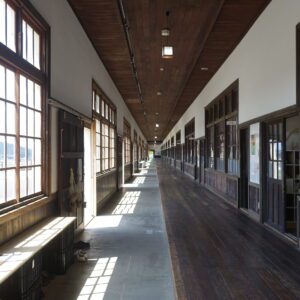
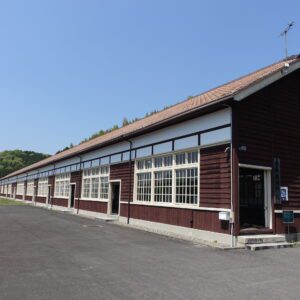
The cityscape of Uno-machi was a very good impression. I regret having scheduled a stay of only one hour. In addition, it has become a city I definitely want to visit.
5. Ozu cityscape
I moved from Uno-machi station to Iyo-Ozu station. The transportation I used is as follows.
Depart Uno-machi Station at 13:15, Yosan Line Limited Express Uwakai No. 16 “bound for Matsuyama”, arrive at Iyo-Ozu Station at 13:38, Fare 1,850 yen
The Uwakai No. 16 I boarded was just an “Anpanman train”.

I rented an electrically power assisted bicycle at the Iyo-Ozu Station Tourist Information Center and took a walk in the city of Ozu. The rental cycle fee for electrically power assisted bicycles is as low as Yen 600 for 2 hours and Yen 1,000 a day. It takes time to walk around the city of Ozu, so it is efficient and recommended to go around the sightseeing bases by bicycle.
Ozu in the early Edo period was the territory of Takatora Todo. Takayoshi Todo, the son of Nagahide Niwa and the adopted son of Takatora, was in Ozu Castle. Ozu is called “Little Kyoto of Iyo”. It was also the location for the movie “Otoko wa Tsurai Yo Torajiro and Tonosama (long-running series of Japanese comedy movies)”.
The steamship Iroha Maru, known to have been used by Ryoma Sakamoto of the Kaientai, is owned by the Ozu Domain and was lent to the Kaientai by the Ozu Domain.
In Ozu, I first visited Nyohoji Temple. It took about 40 minutes on foot from Iyo-Ozu Station, but about 10 minutes by bicycle. Nyohoji is a temple of the Rinzai sect Myoshinji school, which was founded in 1669 by Yasuoki Kato, the second feudal lord of the Ozu domain, with Yotaku Bankei as the founder of the mountain. The Buddhist temple is a national important cultural property.
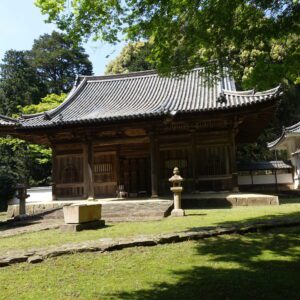
Not only the wonderful Buddhist temple, but also the temple gate and the bell tower are quaint, and I really like Nyohoji. There was also a raccoon dog on the approach to the temple gate. I think it is a typical old temple in the mountains in Japan. It is difficult to go on foot, but I would like many people to rent an electrically power assisted bicycle.
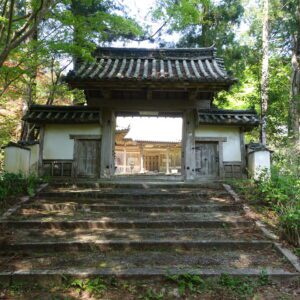
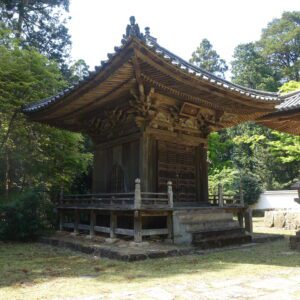
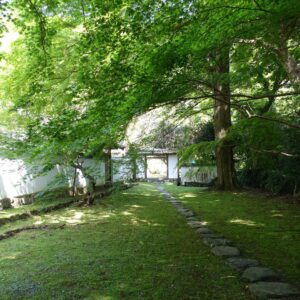
Next to Nyohoji, I went to Bansenso (former Matsui family residence), which is about a 20-minute walk away. It was a little over 5 minutes by bicycle. Bansenso (formerly Matsui Family Residence) is a villa built in 1926 by Kunigoro Matsui, who made a great fortune by running a trading company in the Philippines and running department stores in various places such as Manila. It is a wooden three-story building that stands on a hill. From the window, you can see the natural landscape such as Hijikawa and neighboring mountains.

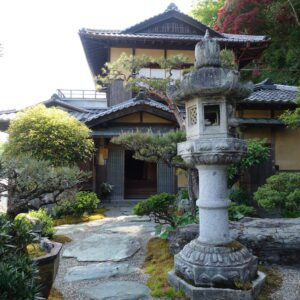
Bansenso will guide you around the building for free. She was a very detailed explanation and was impressed by the smooth explanation.
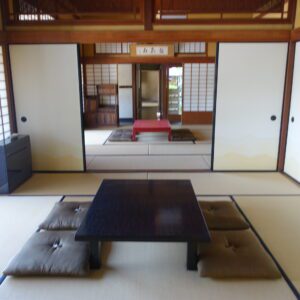
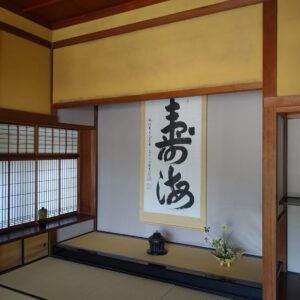
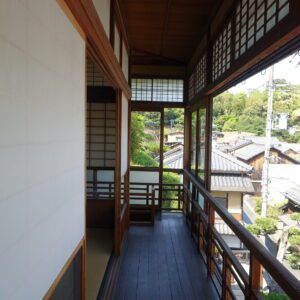
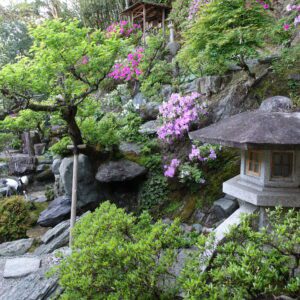
Admission: Adults Yen 550, Children Yen 220
There is a common admission ticket with Ozu Castle and Garyu Sanso for adults Yen 1,100 and children (junior high school students and younger) Yen 440.
Garyu Sanso is a 5-minute walk from Bansenso. Garyu Sanso is a sukiya-style building built in 1907 by Torajiro Kawachi, a trader in the Meiji era, as a villa. It stands on the edge of Hijikawa, which is named “Garyu Fuchi”. It is designated as a national important cultural property, and the area including the garden is a national scenic spot. In 2011, it won one Michelin Green Guide Japan star and was selected as one of the “100 Famous Architectures in the World” by the NHK Dream Museum.
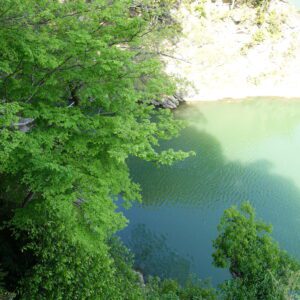
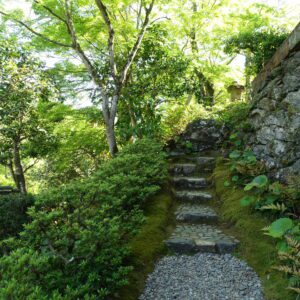
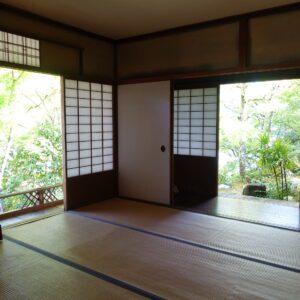


Admission: Adults Yen 550, Children Yen 220
There is a common admission ticket with Ozu Castle and Bansenso for adults Yen 1,100 and children (junior high school students and younger) Yen 440.
I went to “Ozu Redbrick Hall” which is about 5 minutes walk from Garyu Sanso. “Ozu Redbrick Hall” was built in 1901 as the head office of Ozu Commercial Bank. At the time of construction, Ozu was at its peak economically as a distribution base for the manufacture of Japan wax and silk reeling, and shipping.
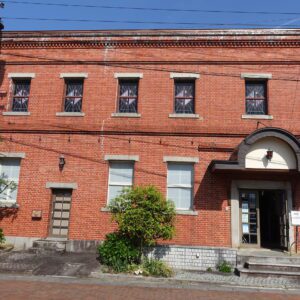
Next, I went to the ruins of Ozu Castle, which is a 10-minute walk from “Ozu Redbrick Hall”. The castle tower of Ozu Castle was demolished in 1888. The current castle tower of Ozu Castle was restored in 2004. The four turrets that have not been dismantled are all designated as national important cultural properties.
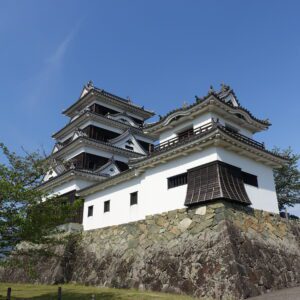

The Sannomaru South Corner Turret is located a little away from the castle tower. Right next to the Sannomaru South Corner Turret, there is the national tangible cultural property “Former Kato Family Omoya,” which is now a hotel.

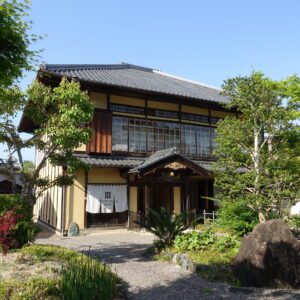
Ozu Castle, which stands on the banks of Hijikawa, looks good in the distant view. It is clear that Takatora Todo, a master of castle construction, successfully used Hijikawa as a natural moat.
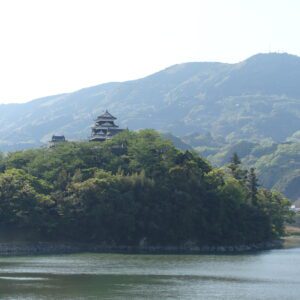
Admission: Adults Yen 550, Children Yen 220
There is a common admission ticket for Garyu Sanso and Bansenso for adults Yen 1,100 and children (junior high school students and younger) Yen 440.
6. Uchiko cityscape
I moved from Iyo-Ozu station to Uchiko station. The transportation I used is as follows.
Depart Iyo-Ozu Station at 16:12, Uchiko Line “bound for Iyo City”, arrive at Uchiko Station at 16:27, Fare Yen 260
“Uchiko Town Yokaichi Gokoku Traditional Buildings Preservation District” is designated as a national Important Preservation Districts for Groups of Traditional Buildings. Uchiko Town was a town that prospered from the late Edo period to the Meiji period due to the production of Japan wax. Currently, there is only one store that produces Japan wax.
I arrived at Uchiko station late at 16:27, so I couldn’t do enough sightseeing in Uchiko. In the cityscape of Uchiko, there were many facilities such as the Japan Wax Museum and Uchiko-za that were open until 16:30. The “Travel Information Center” at JR Uchiko Station closes at 17:00, so give up the rental cycle and take a taxi to the “Yokaichi and Gokoku Preservation Center” (about 5 minutes by car) at the very end of the “Meiji Cityscape”. And I walked back to Uchiko station.
The bicycle with electric assist at the “Travel Information Center” is cheap at Yen 900 within 3 hours and Yen 1,200 a day. Next time, I also want to have more time to enjoy the cityscape of Uchiko.
I was told by a taxi driver that the sunset on Iyo-nada is very beautiful on the “Aiaru Iyo-nada Line” (the seaside section between Iyo-shi Station and Iyo-Ozu Station). There is also a sightseeing train called “Iyo-nada Monogatari”, so when I come to Uchiko next time, I would like to see the sunset of Iyo-nada.
Even though I didn’t have enough time, the cityscape of Uchiko was wonderful. The streets of about 600m are lined with traditional townhouses and mansions of wealthy merchants. Most of the houses are still inhabited by Uchiko people.
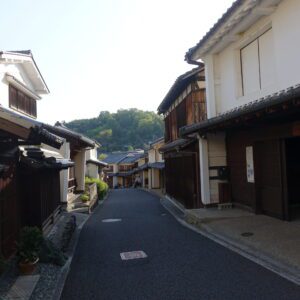

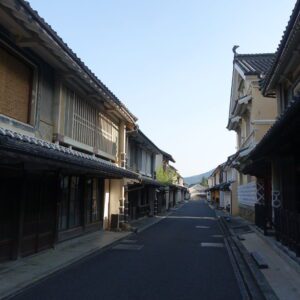
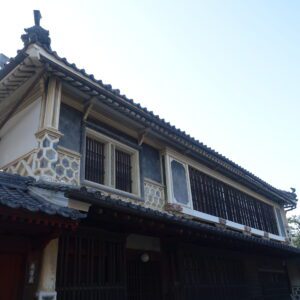
The Kami-haga House, Hon-haga House and Omura House are national important cultural properties.
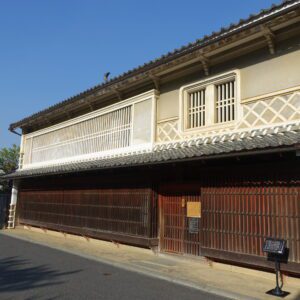
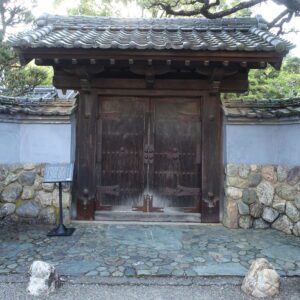


Omoriwa Warosoku is the only remaining Japan wax shop in Uchiko. Japan wax is wax extracted by steaming fruits such as Japanese wax tree (Rhus succedanea) of the family Anacardiaceae, and then squeezing the high melting point fat contained in the pulp and seeds. The candle craftsman explained the Japan wax very carefully. I bought Japan wax for the first time. Japan wax has a very soft feel and feels warm.
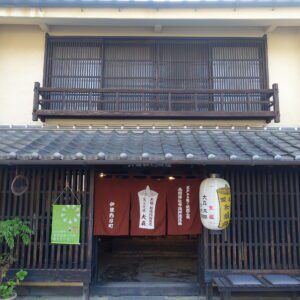
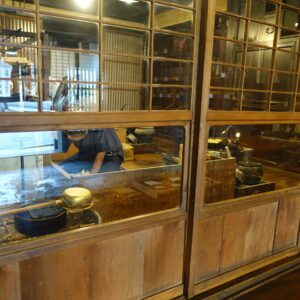
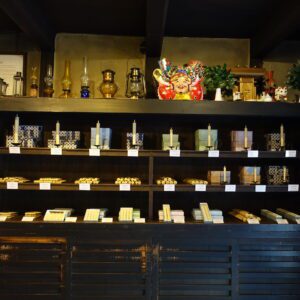
The Iyo Bank Uchiko Branch is a building that imitates the appearance of the former Uchiko Bank, which was built in 1907.

Uchiko Town Children’s Center is a former Uchiko elementary school. It was called “Kaiku School”. The old school building was completed in 1879, but the current Uchiko Town Children’s Center was newly built in 1983, following the appearance of the “Kaiku School”.
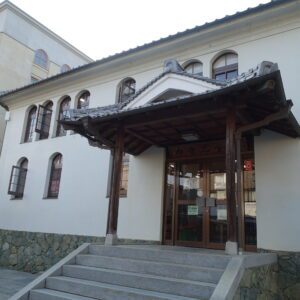
The Uchiko Town Visitor Center is a general tourist information center in Uchiko Town that was completed by renovating the municipal library. It is a former police station built in 1936.
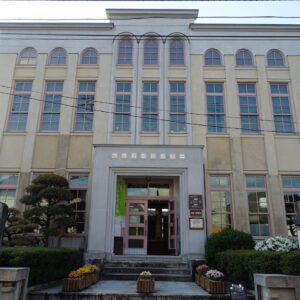
Uchiko-za was founded in 1916 to celebrate the throne of Emperor Taisho. It is a full-fledged playhouse with a pure Japanese style, made of a two-story wooden tiled roof. It is a national important cultural property. I couldn’t tour the inside because the business hours were until 16:30, but I would like to see the inside the next time I come to Uchiko.
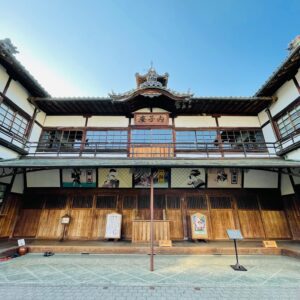
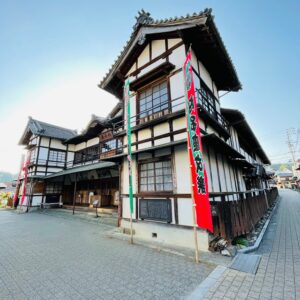
Admission: Yen 400 for adults, Yen 200 for elementary and junior high school students
The “Oni Train” was stopped at Uchiko Station. Kihoku Town, Ehime Prefecture, is the only local government in Japan that has the word “Oni (Demon)” in it, and is promoting town development with the concept of “Demon town.” The “Oni Train” just started operation in July 2021. The “Oni Train” operate 4 trains a day.
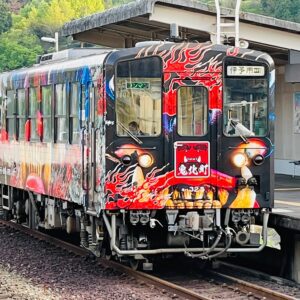
This time, I was able to see 3 types of “YODOSEN FUN FUN TRAINS” out of 5 types, including “Oni Train”, “Shimanto Rocco”, and “Tetsudo Hobby Train” in 2 days. I think I was quite lucky considering the small number of trains that operate 1 to 4 times a day.
The transportation I used to move from Uchiko Station to Matsuyama Station is as follows.
Depart Uchiko Station at 18:07, Yosan Line Limited Express Uwakai No. 24 “bound for Matsuyama”, arrive at Matsuyama Station at 18:34, Fare Yen 2,060
I was able to secure a seat, but the Uwakai No. 24 regular car was quite crowded.
The limited express “Shiokaze No. 30” that goes to Okayama station stopped at Matsuyama station. The 8000 series of “Shiokaze No. 30” vehicles won the 2005 Good Design Award.
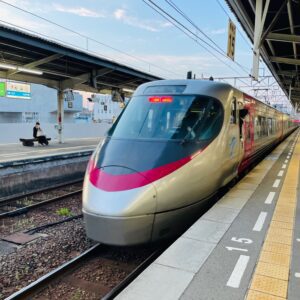
Note: The departure / arrival times, fares of transportation, admission fees, meal fees, etc. listed in the text are as of the time of writing the BLOG. Please check for yourself when you go on a trip as it may change in the future.
